Connected cars will send 25 gigabytes of data to the cloud every hour
For most of us, the living room is the most connected room in the home. But within a few years that honor might extend into the garage instead.


For most of us, the living room is the most connected room in the home. But within a few years that honor might extend into the garage instead.
Connected cars, which carry embedded mobile broadband chips and on-board computers, are about to change everything about the way we live with cars.
Twenty-five gigabytes: that’s how much data a connected car will upload to the cloud every hour (PDF). That’s equal to about a dozen HD movies and exceeds the storage capacity of most smartphones today. What’s the car telling the network in such great volume?
The short answer is: data about everything. Its route, its speed, the wear and tear on its components, and even road conditions. Vehicles today have about 40 microprocessors and dozens of sensors that collect telematics and driver behavior data, and that data can be analyzed in real-time to keep the vehicle’s performance, efficiency, and safety in check. It also provides vital feedback for cities and states about traffic volume and roadway design.
Clarion’s award-winning Smart Access platform is beginning to bring the infotainment system to automobile manufacturers. The platform’s advanced cloud-based service enables vehicles to share and analyze the data they generate, but also has entertainment components, allowing passengers to get onto social media, view vehicle information, and connect various other apps to their car.
Smart Access owes its “intelligence” to Hitachi, whose smart protocols allow machines to communicate with one another and sync themselves with intelligent infrastructure. Finding insights amongst machine data is something Hitachi has been doing for decades.
The impact of that machine data will be enormous. With smart infrastructure and driver telematics promising to relieve traffic and reduce driver error, over 10,000 fatalities and as many as 500,000 injuries might be preventable every year in the United States alone.
Those kinds of improvements will take time and changes in both public and private realms but by 2016, over 1/3 of all circulating cars in Western Europe should be connected thanks to EU legislation. That proportion will reach about 90% by 2020.
However, laws won’t be necessary to convert most drivers to newer, more connected vehicles. Besides the safety benefits, there’s quality of life to consider: the typical American commuter spends 250 hours a year in his or her car. The combination of autonomous driving and in-car entertainment could allow drivers to read e-books, communicate with colleagues, watch documentaries, or browse their vacation photos–without fear of their inattention causing a collision. That’s a destination all cars should head towards.
Read more about Hitachi’s vision for social innovation for transportation.
This article was produced on behalf of Hitachi by the Quartz marketing team and not by the Quartz editorial staff.